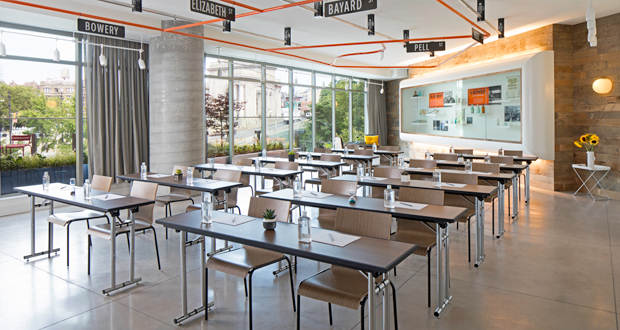
Two Roads Hospitality has released data from its recently conducted “State of the Meetings Industry” survey revealing 2018’s top meeting trends. In its sixth annual survey, the company analyzed responses from more than 300 corporate, association, government, and independent planners—66 percent of whom control more than $100,000 per year in guestroom, meeting space, and food and beverage spend for their organizations.
Below are seven key insights that the survey garnered around meeting planning, execution, and participation.
Overall Market Strength and Stability
The year ahead will see a strong showing in corporate meeting spending, according to the survey. Thirty-seven percent of survey respondents said they will plan more meetings for 2018, up from 30 percent in 2017. Nearly 45 percent of survey respondents said they have more money to spend in 2018. In addition to a higher demand, the new year will see an increase in costs and a shift in where meetings are planned.
“Meetings are seeing costs rising because there’s strong demand from the leisure and transient segments and because much of the new hotel supply is in the economy or mid-scale categories—which tend to lack meeting facilities and the leisure amenities preferred by both planners and attendees,” says Andre Fournier, executive vice president of sales, marketing, and revenue for Two Roads Hospitality.
“With 84 percent of survey respondents using upscale, upper-upscale, or luxury properties, it is anticipated that these segments will experience stronger demand than supply,” Fournier continues.
Value is a Booking Driver
Value significantly informs decisions around meeting bookings, and the way it is measured is crucial for success. The meetings industry will continue to emphasize the importance of delivering a quantifiable return on investment to both the attendees and the organization, determining this return through numbers-driven and perception-driven calculations.
Creating an Interactive and Inspiring Atmosphere
More than 74 percent of those surveyed rated flexible meeting space as an eight, nine, or 10 out of 10 in importance when organizing a meeting or event. Non-traditional elements, such as an informal living-room concept or a comfortable, lounge-style seating area, and unexpected spaces like urban rooftops, are becoming commonplace. Many meeting planners are also seeking mixed environments that blend the traditional conference table with a residential element, resulting in warm, transitional spaces that can evolve from one event to another.
“With many sessions transitioning from being instructor-led to being attendee-led, the atmosphere must be convivial like at a coffee house,” explains Fournier.
Food and Beverage: Making Meetings Delicious
Food and beverage ranked as the third-most important factor in site-selection decisions, behind only location and rate, with the average rating of importance increasing from 8.6 in 2016 to 8.74 in 2017.
“How we source our food in the past several years has changed significantly,” Fournier says. “Farm-to-table dining and local, organic ingredients are what our guests want. Freshness and quality are crucial, and there’s a strong demand for health-conscious cuisine from our planners. Additionally, the local emphasis gives attendees a deeper connection to the community and local culture, making it a more memorable experience that they’ll share with others.”
Venues have an opportunity to provide destination-specific F&B offerings that may be new to participants. Planners also know quality options will result in maximum performance for attendees.
Meeting Planning in the Digital Age
On-site technology plays a key role in today’s meetings, with 61 percent of planners ranking it eight, nine, or 10 in importance for the planning of 2018 meetings. Bandwidth is a top concern, especially given the robust nature of event apps, social media platforms, and other web applications used during meetings. Some technologies that meeting planners and hospitality companies are increasingly using include virtual reality site tours and texting solutions that allow planners to communicate in real time with any department on the property to fulfill a need or request.
“We are piloting virtual reality site tours at a number of our properties, but the product made a strong first impression when planners could experience, for instance, a 360-degree view from a scenic outdoor terrace that hosts receptions,” says Kevin Barosso, vice president of global sales for Two Roads Hospitality.
Teambuilding: Leveraging Local Experiences
Nearly 40 percent of survey respondents rated leisure and teambuilding amenities as a seven or higher in importance when choosing a site. More than half expressed interest in adventure or active teambuilding, while 47 percent prefer public service-focused activities. Locality plays a key role when planning teambuilding activities and meeting breaks. Immersive activities unique to the destination leave long-lasting impressions, further enhancing the meeting experience.
Safety Concerns
Safety concerns are impacting the business meeting and event industry, according to the survey. Planners are working closely with venues to ensure the safety of their guests, learning about security details already in place, and establishing emergency prevention and response plans.
Top photo: The gallery classroom at Hotel 50 Bowery, a Joie de Vivre hotel












This is the information I am looking for. This article is clear and easy to understand. I’m learning more about this. Hope you bring more things related to it. Thanks a lot!